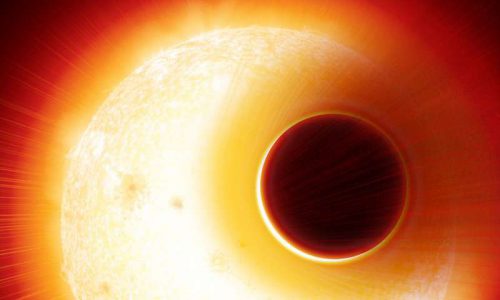Helium is the second most common element in the universe. Since 2000, scientists have predicted that it would be possible to discover planets orbiting other suns, whose atmospheres contain helium. It took 18 years before such a planet was actually discovered

An artist's illustration of the planet HAT-P-11b surrounded by a helium atmosphere coming from its sun - an orange dwarf - smaller but more active than the sun. Illustration: © Denis Bajram
Although helium is a rare element on Earth, it is found everywhere in the universe. After hydrogen, helium is the main component of stars and giant planets. Despite its abundance, helium was only recently discovered in the atmosphere of a gas giant by an international team, led by astronomers from the University of Geneva (UNIGE), in Switzerland. The team detailed for the first time how gas escaping from the planet's atmosphere causes it to become overinflated, like a helium balloon.
Helium is the second most common element in the universe. Since 2000, scientists have predicted that it would be possible to discover planets orbiting other suns, whose atmospheres contain helium. It took 18 years before such a planet was actually discovered. It was difficult to observe due to the spectral signature of helium, which is in the infrared region, outside the range of the instruments used so far.
During the last year, thanks to an observation on the Hubble Space Telescope that was difficult to interpret, the team members who also belong to the National Planetary Research Center, came up with the idea of using a telescope to which a new spectrograph is connected - known as Carmenes.
A spectrograph breaks down the starlight into its component colors like a rainbow. The data obtained from the spectrograph is a measure indicating the number of colors that can be detected. While the human eye cannot distinguish between infrared shades without an adapted camera, the infrared eye of the 'Hubble' is able to detect hundreds of colors. This was enough to detect the spectral signature of the helium. The Carmenes instrument, mounted on a 4-meter telescope at the Calar Alto Observatory in Andalusia, Spain, is capable of detecting more than 100,000 infrared colors.
This high spectral resolution allowed the team to examine the location and speed of helium atoms in the upper atmosphere of a planet the size of Neptune, four times the size of Earth. The planet HAT-P-11b is located in the Cygnus constellation, 124 light years away. It is a "hot Neptune" (550 degrees Celsius), but it is 20 times closer to its sun than the Earth. "We suspected that this closeness with the star could affect the atmosphere of this planet," says Roman Allert, PhD student at UNIGE and first author of the study. "The new observations are so precise that they show that the atmosphere of the planet is undoubtedly inflated by its solar radiation and escapes into space," he adds.
These observations are supported by a computer simulation performed by a team led by Vincent Bourrier, a co-author of the study and a member of the European FOUR ACES project. Thanks to the simulation, it is possible to follow the trajectory of the helium atoms: "Helium moves from the bright side of the planet to its shadowy side at a speed of over 10,000 km/h," explains Bouria. "Because it is such a light gas, it easily escapes the planet's pull and forms an extended cloud around it. This gives the HAT-P-11b the shape of an inflated helium balloon.
This finding opens a new window for examining the extreme atmospheric conditions prevailing on the hottest planets. Carmenes' observations show that these kinds of observations, previously thought to be possible only from space, can be made with greater precision by ground-based telescopes equipped with the right kind of instruments. "These are exciting times for the search for atmospheric signatures of planets," says Christoph Lovis, senior lecturer at UNIGE and author of the study.
UNIGE astronomers were also involved in the design and operation of two new high-resolution infrared spectrographs, similar to Carmen. One of them, called SPIRou, is in Hawaii, while UNIGE's astronomy department is conducting the first tests of the Infrared Planet Searcher (NIRPS), which will be installed in Chile at the end of 2019. "The installation will increase the interest of the scientific community in these instruments. Their number and geographical distribution will allow us to cover the entire sky, in search of planets," Lovis concludes.
More of the topic in Hayadan:
